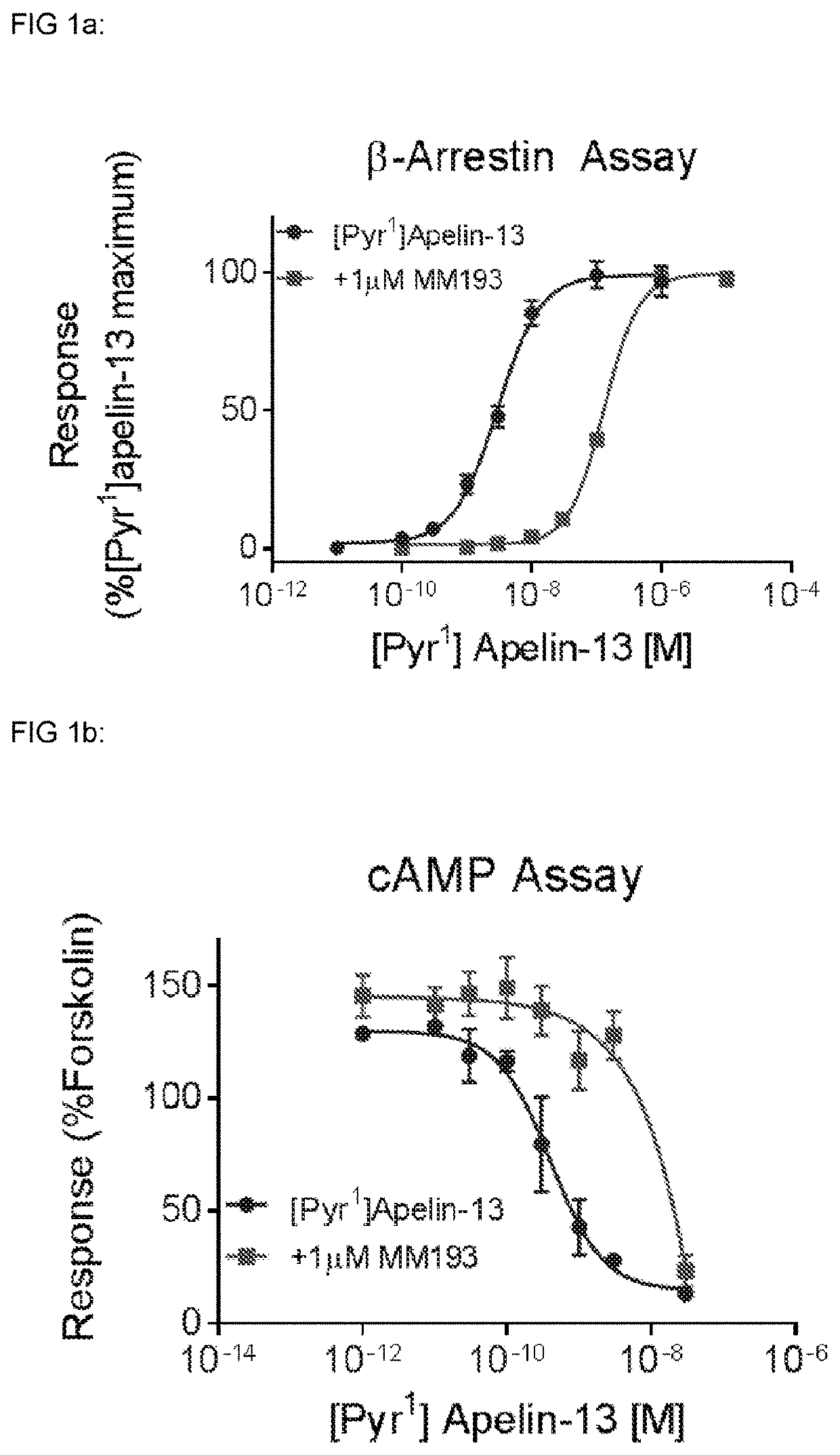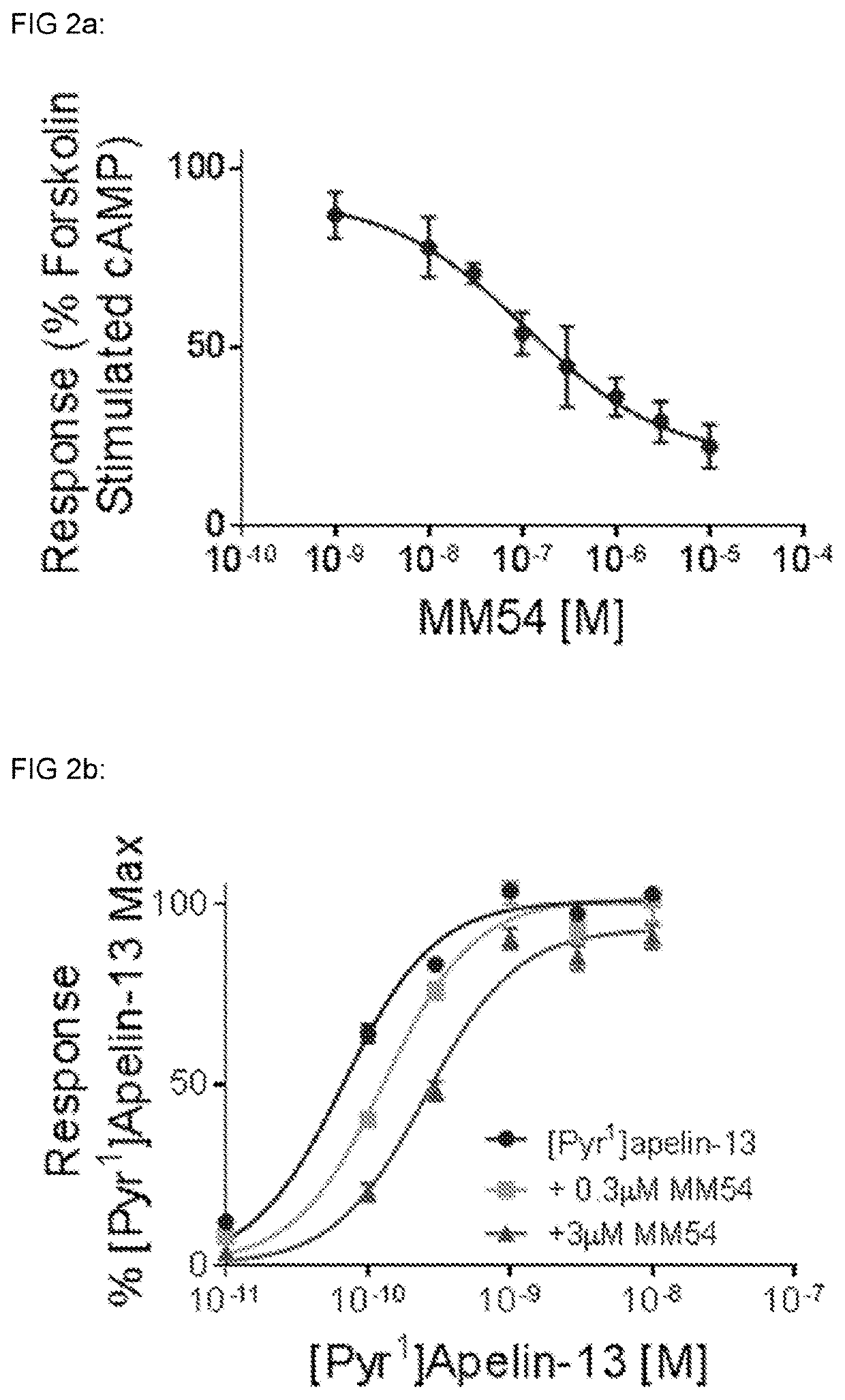Compounds for use as apelin receptor antagonists
- Summary
- Abstract
- Description
- Claims
- Application Information
AI Technical Summary
Benefits of technology
Problems solved by technology
Method used
Image
Examples
example 3
[0488]MM301, Pyr-RPR-Nle-Abu-KH-Abu-R-Aib-R-Nle-(3,4,5-trifluoro-)F, has a binding affinity of Ki=28 nM at the apelin receptor (Cerep) and a pA2=7.28 in the DRx β-Arrestin assay and a pA2=6.29 in the DRx cAMP assay.
[0489]The therapeutic effects of apelin receptor antagonists are due to effects on β-Arrestin or cAMP signalling or a combination of both. Compounds may display pA2 values consistent inhibition of β-Arrestin and / or the cAMP signalling with pA2 values from 0-10, preferably with pA2 values from 4-10.
example 1
of Compounds
[0490]Peptides MM54, MM107, MM108, MM193, MM262. Syntheses were performed by Cambridge Peptides (Cambridge Peptides Limited, 1 Philip Victor Road, Birmingham, West Midlands, B20 2QB, UK) using a PT Symphony and using standard Fmoc chemistry, purified by RP-HPLC on C18 columns. Where applicable, the peptides were cyclised using iodine oxidation, and purified by RP-HPLC. Peptides were analysed by LCMS and mass spectrometry.
[0491]Peptides MM297, MM298, MM299, MM300, MM301, MM302, MM312, MM313, MM314, MM315, MM316. MM412, MM413, MM414, MM415, MM416, MM417, MM418, MM419, MM420, MM421, MM422, MM423, MM424, MM426, MM428.
[0492]Syntheses were performed by Pepmic Co., Ltd. NO. 35 XingXian Road, High-tech Development Zone, Suzhou, China 215151 using standard fMOC synthesis. Peptides were analysed by LCMS and mass spectrometry.
[0493]The final peptide was purified by preparative HPLC using COSMOSIL C18 (30*250 mm, 15 μm, 100 Å), eluted with a linear gradient of CH3CN (11-20% (00520-5...
example 2
nd Functional Assays
[0496]Binding assays were performed by Cerep (Celle L'Evescault, France) on Chinese Hamster Ovary (CHO-K1) cells expressing the human apelin receptor. Initial experiments were performed to determine whether a single concentration of test peptide (1 or 10 μmol / L) inhibited specific binding of [Glp65, Nle75, Tyr77][125I]apelin-13 (0.03 nmol / L). The results were expressed as a percent of control specific binding ((measured specific binding / control specific binding)×100) and as a percent inhibition of control specific binding (100−((measured specific binding / control specific binding)×100)) obtained in the presence of the test compounds. Results showing an inhibition higher than 50% was considered to represent significant effects of the test compounds. Results showing an inhibition between 20% and 50% were indicative of weak to moderate effects. Results showing an inhibition lower than 20% were not considered significant and mostly attributable to variability of the s...
PUM
| Property | Measurement | Unit |
|---|---|---|
| Molar density | aaaaa | aaaaa |
| Molar density | aaaaa | aaaaa |
| Molar density | aaaaa | aaaaa |
Abstract
Description
Claims
Application Information
 Login to view more
Login to view more - R&D Engineer
- R&D Manager
- IP Professional
- Industry Leading Data Capabilities
- Powerful AI technology
- Patent DNA Extraction
Browse by: Latest US Patents, China's latest patents, Technical Efficacy Thesaurus, Application Domain, Technology Topic.
© 2024 PatSnap. All rights reserved.Legal|Privacy policy|Modern Slavery Act Transparency Statement|Sitemap



